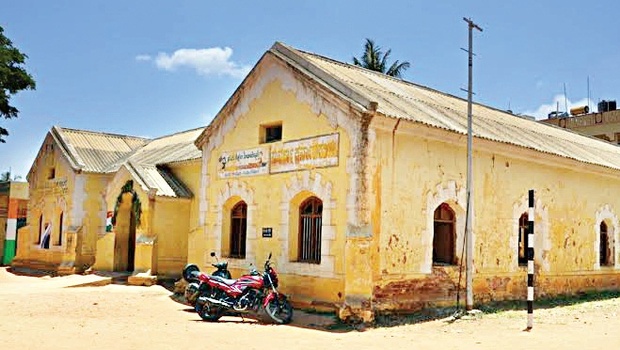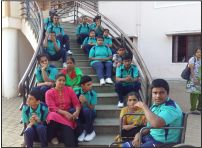A Scholar Extraordinary: Dr. S. Srikanta Sastri
![1) Dr. S. Srikanta Sastri [1904-1974] 2) A group photo of B.A. Honours (1936 - 37), Maharaja’s College. Sitting (on chairs): Sathyagirinathan, V. Raghavendra Rao, S. Srikanta Sastri, N. Kasturi, M. H. Krishna, Sri Jayachamarajendra Wadiyar, J. C. Rollo, C. S. Seshadri, H. Muddaraje Urs, A. Sharadamma and Y. Venkamma; Standing (first row): B. Basappa, B. S. Rama Rao, K. S. Venkatanarayana, A. S. Lakshminarayana Rao, S. Mohammed Zakaria, A. S. Jagannath, S. Devaraje Urs, M. S. Bhimasenachar, M. V. Lakshmana Rao and D. L. Narasimha Sastry; Standing (second row): B. K. Raghunatha Murthy, M. L. Krishna Murthy, M. L. Ramaswamy, B. V. Venkannachar, C. V. Venkatesaiah, K. B. Ramaswamy Iyengar, B. Chikke Urs, V. S. Krishna Murthy and B. Puttaraje Urs; Standing (third row): B. V. Keshava Iyengar, D. Chokkanna and K. S. Subba Rao.](http://www.bangalorefirst.in/wp-content/uploads/2016/04/ScholarsBF03apr2016.jpg)
Dr. Bhagirath, who is presently a Consultant Anaesthesiologist at Rainbow Children’s Hospital, Bangalore, was formerly at JSS Hospital, Mysore. Apart from Medicine, Dr. Bhagirath’s core passion is study of English Literature, writing and reading poetry, collecting information on Indus Valley artifacts and deciphering of Indus Valley Scripts.
Here we publish the special article as a befitting tribute to the polyglot in the Centenary Year of the University. Now read on.—Ed
—–
“It is scholars like Dr. S. Srikanta Sastri who build and make the reputation of a University. A University contributes precious little to build a scholar like S. Srikanta Sastri.”
— Dr. U. R. Ananthamurthy, Jnanpith awardee
——
by Dr. S. N. Bhagirath
During the Centenary Year of the University of Mysore, many of its luminaries, scholars, scientists, technologists and litterateurs of yesteryears are remembered with nostalgia. Among this galaxy of stars, Dr. S. Srikanta Sastri, the historian, stands out as a scholar of international fame on par with Dr. A. Venkatasubbaiah (Berne Univ.). On the advice of this historian, the corrected version of the Asoka pillar now stands in front of Maharaja’s College. The earlier pillar had various animals like the Bull, Lion, Elephant and Horse pushing the Dharma Wheel from the either side and not going anywhere!
He was an extraordinary teacher and research scholar with knowledge of fourteen languages. He took up the first research project of the University of Mysore in 1925 to lay the foundation of Karnataka history by writing “Sources of Karnataka History, Vol I.” In 1926, he published his first research article “The Conquests of Siladitya in the South” in the ‘Journal of Royal Asiatic Society of Great Britain & Ireland.’ Srikanta Sastri happens to be the second person in the University of Mysore to receive a D. Litt degree in 1949 for his contribution to Indology. He preoccupied himself with Karnataka history, when in reality only Princely Mysore State existed. He wrote extensively in English, Kannada, Telugu, Hindi and Sanskrit. He was a personal friend of Prof. M. V. Gopalaswamy, Head of the Department of Psychology and later Principal of Maharaja’s College, Mysore. Srikanta Sastri collaborated with Gopalaswamy in nurturing his pet project of Radio Broadcasting (Akashavani). Later, Prof. Sastri delivered more than twenty lectures in English and Kannada on All India Radio (Akashavani) from Mysore, Bangalore and Dharwad. Through his famous student Gorkha Dakshin Bahu Y. G. Krishnamurti (Nepal), he was keeping in touch with Pt. Jawaharlal Nehru and Subhash Chandra Bose. Nehru sent the first print copy of “Discovery of India” to Prof. Sastri and wanted to know his opinion. Srikanta Sastri later wrote an article titled “Nehru as a historian.” Sastri also contributed an anonymous article to Haripur Congress Souvenir in 1938 with the title “The History of Congress Polity.” This was a historic session where Mahatma Gandhi’s conscience candidate Pattabhi Seetaramaiah lost his election against Subhash Chandra Bose. To this souvenir Netaji Subhash Chandra Bose has sent a special message as President of the Congress party. Sastri’s student Y. G. Krishnamurti is the editor of this souvenir.
Srikanta Sastri’s introduction to Y.G. Krishnamurti’s book “Independent India and a New World Order” in 1943 attracted the attention of Joseph Goebbels – Adolf Hitler’s propaganda chief, who announced Sastri’s name along with that of Dr. S. Radhakrishnan over Berlin Radio one evening. This prompted the British Secret Service to arrest and interrogate Srikanta Sastri about his activities. This German broadcast was heard by several of his students, who began to hero worship him. He also had the courage of conviction to write an article during the time of Nalwadi Krishnaraja Wadiyar with the title “Is the Maharaja of Mysore a True Sovereign?” This article invited the wrath of the then Diwan of Mysore State Sir Mirza Ismail and one must remember Prof. Sastri was still teaching at Maharaja’s College. This firebrand professor also taught Prince Jayachamarajendra Wadiyar — History in the year 1936-37.
In 1943, he wrote a futuristic historical work “Geo-politics of India & Greater India,” which predicted a greater role for the Indian nation after Independence in South East Asia. He also predicted that India had the potential of becoming a world superpower with its large population and rich mineral resources. He heralded the formation of Karnataka State on Nov. 1, 1956 with a series of articles glorifying the history, culture and diversity of our State. His most famous work “Bharathiya Samskruthi” in Kannada has seen five reprints. In all, he authored about 12 books and 224 articles during his lifetime. His collected English works “Srikantayaana – Vol I & Vol II” is being brought forth by Mythic Society, Bangalore in 2016.
When he retired in 1960, the UGC appointed him as the first Emeritus Research Scholar of Mysore University. He was honoured by the University of Mysore during the Vice-Chancellorship of Dr. D. Javaregowda in 1973 with a Festschrift Volume by name “Srikanthika.” This volume contains scholarly articles of very high standard written by T. V. Mahalingam, S. R. Rao, S. Settar, B. R. Gopal, M. Chidanandamurthy, K. V. Ramesh, B. Sheikh Ali, T. V. Venkatachala Sastry, S. S. Raghavachar and A. V. Narasimha Murthy. The then Governor of Karnataka State Mohanlal Sukhadia honoured Prof. Srikanta Sastri during the Diamond Jubilee Celebration of the Mythic Society, Bangalore. The Kannada Sahitya Parishat honoured him during the Annual Sahitya Sammelan in Bangalore in 1970. He was one of the first of the Indian historians to refute the Aryan invasion theory hoisted by the westerners. He wanted Indian history and especially Karnataka history to be written by Indian historians who had an insight into the Indian culture and philosophy. He passed away in 1974. His centenary was celebrated in 2004 by the Mythic Society by conducting a two-day national seminar.
His most famous students are: Former VC Dr. D. Javaregowda, Dr. T. V. Venkatachala Sastry, R. K. Laxman and his brother R. K. Narayan, Sri Jayachamarajendra Wadiyar, H. Y. Sharada Prasad, U. R. Ananthamurthy, T. S. Satyan, S. R. Rao, M. S. Nagaraj Rao and his oldest living student Dr. G. Venkatasubbaiah. Some of his contemporaries were B. M. Sri, Ti Nam Sri, D. L. Narasimhachar, Kuvempu, Rallapalli Anantha Krishna Sharma, Prof. Nikam and M. H. Krishna.
Srikanta Sastri Gold Medal has been instituted by the historian himself to be awarded to a M. A. student who scores highest marks in cultural history of Karnataka in the University of Mysore.
[Dr. S. N. Bhagirath can be contacted on Mob: +91 – 9886803724 or email: bugs2beatles@gmail.com; Visit: www.srikanta-sastri.org]
source: http://www.starofmysore.com / Star of Mysore / Home> Feature Articles / April 03rd, 2016






